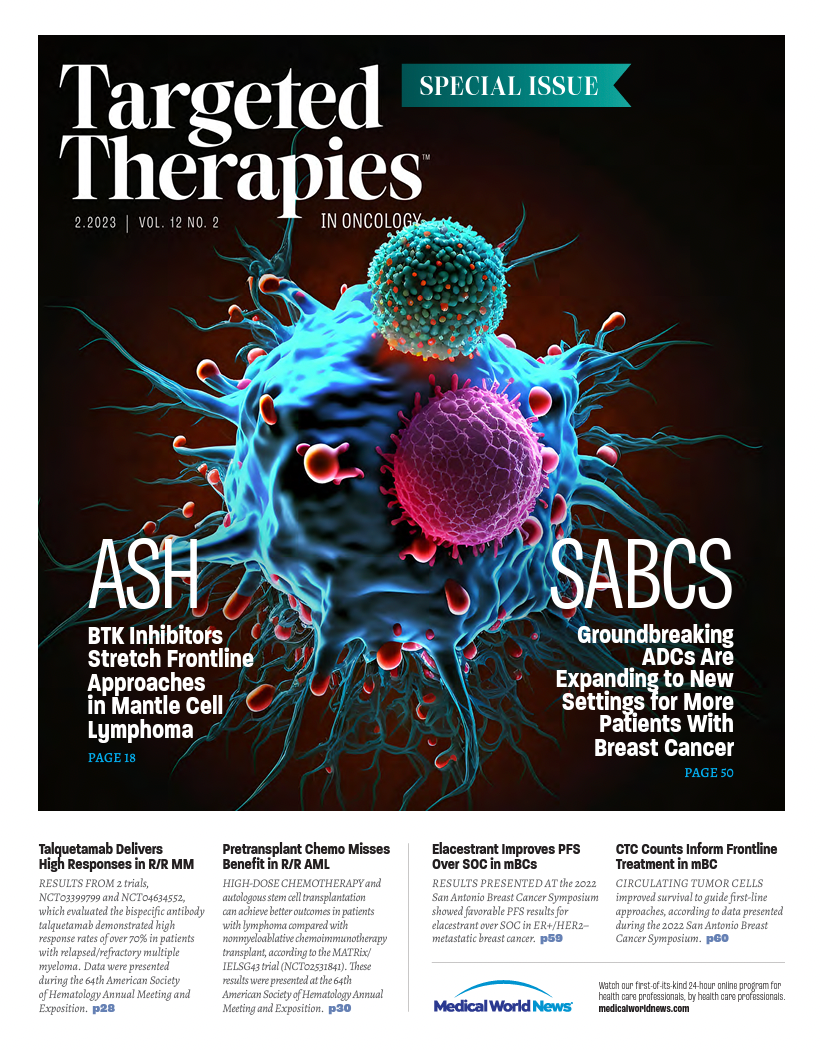No Survival Advantage When Chemotherapy Is Given Prior to Transplant in R/R AML
In the phase 3 ETAL3-ASAP trial, patients with relapsed/refractory acute myeloid leukemia given an allogeneic hematopoietic cell transplant had similar overall survival rates vs those given intense salvage chemotherapy first.
Johannes Schetelig, MD, MSc

In patients with relapsed or refractory acute myeloid leukemia (AML), those who received an allogeneic hematopoietic cell transplant (alloHCT) attained similar overall survival rates compared with those who first received intense salvage chemotherapy to achieve complete response (CR), according to results from the phase 3 ETAL3-ASAP trial (NCT02461537). These findings run counter to the common practice of offering stem cell transplantation only to patients who have achieved CR, suggesting that patients may skip salvage chemotherapy before receiving a transplant. Results were presented during a press briefing at the 64th American Society of Hematology Annual Meeting and Exposition.1
Patients were randomized 1:1 to a remission induction strategy (RIST arm) with 3 g/m2 cytarabine (1 g/m2 for patients >60 years) twice daily on days 1-3 plus 10 mg/m2 mitoxantrone on days 3 to 5 and subsequent alloHCT or to disease control (DISC arm) prior to sequential conditioning and alloHCT.
Findings from the phase 3 clinical trial showed that the primary end point of disease-free survival (DFS) at day 56 was reached by 84.1% of those in the DISC arm (n = 139) and 81.3% of those in the RIST arm (n = 137; P = .047). Although this missed statistical significance against the 1-sided α level of 2.5%, the probability that the true success rate in the investigative arm is below the noninferiority margin is only 4.7%, said study author Johannes Schetelig, MD, MSc, of the University Hospital Carl Gustav Carus in Dresden, Germany, in a presentation of the data.
Schetelig said the authors acknowledged that DFS at day 56 is not an accepted surrogate end point following transplantation. At a median follow-up of 37 months, no difference in leukemia-free survival from day 56 (P = .061) or overall survival (OS) from randomization (P = .047) was observed between the DISC and RIST arms.
“Our conclusions are that patients with poor response after first induction chemotherapy or first relapse of AML do not benefit from salvage chemotherapy with high-dose cytarabine plus an anthracycline prior to transplantation,” Schetelig said.
“Watchful waiting and sequential conditioning prior to allogeneic transplantation result in comparable CR rates and OS and may be the preferred option whenever a stem cell donor is readily available.” In patients with AML, CR before alloHCT is known to be a favorable risk factor. Intensive chemotherapy can be given prior to alloHCT to try to induce CR, but it is unknown whether those with relapsed or refractory disease derive a benefit from this approach. Sequential conditioning with high-dose cytarabine or melphalan followed by reduced intensity conditioning and alloHCT has resulted in long-term disease control for this population. In the study, the induction chemotherapy comprised high-dose cytarabine and mitoxantrone followed by alloHCT in patients with relapsed or refractory AML. “Our hypothesis was that salvage chemotherapy would not provide a net benefit for patients with high-risk AML,” Schetelig said.
To test this hypothesis, investigators enrolled adult patients with high-risk AML following first induction therapy or first untreated relapse who were fit for intensive chemotherapy and alloHCT. Patients were required to have a matched sibling donor, a human leukocyte antigen (HLA)- compatible unrelated donor, or an ongoing donor search with 2 potential unrelated donors and an HLA-matching probability of at least 90%.
Study participants were randomly assigned 1:1 to the RIST arm or the DISC arm. Those in the RIST arm received salvage chemotherapy with cytarabine at 3 g/m2 (1 g/m2 for those older than 60 years) twice daily on days 1 to 3 plus mitoxantrone at 10 mg/m2 on days 3 to 5 followed by alloHCT. In the DISC arm, watchful waiting was recommended, but low-dose cytarabine and single doses of mitoxantrone were allowed for disease control. This was followed by sequential conditioning and alloHCT.
The primary end point of the trial was treatment success, which was defined as DFS at day 65 following alloHCT. Investigators sought to demonstrate noninferiority for the DISC arm, with a margin of 5% and a 1-sided α level of 2.5%. OS from randomization and leukemia-free survival from day 65 served as key secondary end points.
The median age in the DISC and RIST arms was 61 years. Less than half of patients were female (45% vs 42%, respectively), and most patients had an ECOG performance status of 0 or 1 (88% vs 90%). “Patients had active disease—two-thirds defined by poor induction response and one-third defined by relapsed AML,” Schetelig noted.
In the DISC arm, the median time to transplantation was 4 weeks, and of note, 76% of patients were cared for by watchful waiting only during that period. Sixteen weeks from being randomly assigned, 97% of the intention-to-treat population had undergone transplant.
In the RIST arm, Schetelig noted that every second patient achieved a CR with salvage chemotherapy. The median time to transplantation was 8 weeks. “I would like to highlight that most patients who had not achieved a CR still proceeded to transplantation—72% after sequential conditioning,” he said. In this arm, 93% of patients received transplants by week 17 after random assignment.
The incidence of adverse effects of grade 3 or above was lower in the DISC arm vs the RIST arm, at 23% and 64%, respectively (P < .001). Notably, those in the DISC arm also spent less time in the hospital prior to transplantation vs those in the RIST arm, at a mean of 19 days (range, 7-63) vs 42 days (range, 9-75; P < .001). The mortality rates on day 28 from time of random assignment were 3.6% in the DISC arm vs 1.5% in the RIST arm.
In the DISC arm, 4 patients did not undergo transplant because of death due to sepsis (n = 2), leukemia (n = 1), or a decision against alloHCT (n = 1). In the RIST arm, 6 patients did not undergo alloHCT because of death due to pneumonia (n = 3), immune checkpoint blockade (n = 1), refractory AML (n = 1), or a decision against it (n = 1).
Time to discharge and in-hospital mortality did not differ between the 2 arms, Schetelig added. “A more general conclusion and forward-looking statement is that the benefit of any treatment [aimed] at better results after allogeneic transplantation by inducing a CR prior to transplantation should be demonstrated in prospective clinical trials,” Schetelig said.
REFERENCE
1. Stelljes M, Middeke JM, Bug G, et al. In patients with relapsed/refractory AML sequential conditioning and immediate allogeneic stem cell transplantation (allo-HCT) results in similar overall and leukemia-free survival compared to intensive remission induction chemotherapy followed by allo-HCT: results from the randomized phase III ASAP trial. Blood. 2022;140(suppl 1):9-11. doi:10.1182/blood-2022-159962
Survivorship Care Promotes Evidence-Based Approaches for Quality of Life and Beyond
March 21st 2025Frank J. Penedo, PhD, explains the challenges of survivorship care for patients with cancer and how he implements programs to support patients’ emotional, physical, and practical needs.
Read More
